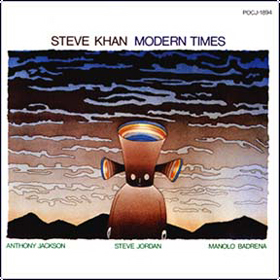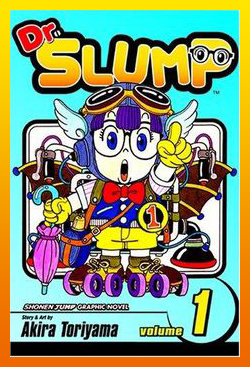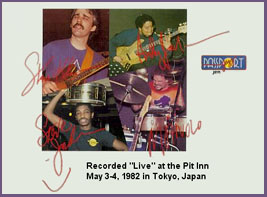Steve Khan's "Penguin Village" Lead sheet
Though 1982 seems like a lifetime ago, I have many memories of that time. I recall that, after we had recorded "EYEWITNESS" and it had been released in Japan, causing a bit of a sensation, we were told that we would be going there to play live at the famous Pit Inn located in Rappongi, a district within Tokyo. But, more than this, we were offered the chance to make a "live" recording of our very first time playing in front of people. Be assured, a certain amount of panic began to infiltrate my every thought. There would not be enough time to jam-up sufficient new material. So, I got very serious over a period of weeks and composed "Blades"; "The Blue Shadow"; and "Penguin Village." The first two tunes mentioned have already been presented here at Korner 2. When the recording was released in Japan, it was originally titled, "MODERN TIMES." However, when a deal was worked out for it to be released here in the U.S. on Passport Jazz Records, Steps Ahead had also just released a new recording under that same title. So, rather than compete with that, the U.S. release was to bear the title of "BLADES." On a side note, in one of the absolute dumbest moves I ever made, I allowed my then lawyer to talk me into only selling the LP rights to Passport Jazz and that 'we' would sell the CD rights to someone else because Passport Jazz was not offering much of an advance. This was mostly because their label was just about to launch and they needed 'product' to add some bulk and stability to the initial release. In the end, "BLADES" was never released as CD in the U.S. nor in Europe. I can't begin to explain just how stupid I have come to feel about this. The first two tunes mentioned have already been presented here at Korner 2. When the recording was released in Japan, it was originally titled, "MODERN TIMES." However, when a deal was worked out for it to be released here in the U.S. on Passport Jazz Records, Steps Ahead had also just released a new recording under that same title. So, rather than compete with that, the U.S. release was to bear the title of "BLADES." On a side note, in one of the absolute dumbest moves I ever made, I allowed my then lawyer to talk me into only selling the LP rights to Passport Jazz and that 'we' would sell the CD rights to someone else because Passport Jazz was not offering much of an advance. This was mostly because their label was just about to launch and they needed 'product' to add some bulk and stability to the initial release. In the end, "BLADES" was never released as CD in the U.S. nor in Europe. I can't begin to explain just how stupid I have come to feel about this.
In truth, I haven't listened to this tune in years. Now, being forced to hear it again, because I had to make certain that the lead sheet was accurate, I couldn't help but notice many things. The tone of my Gibson ES-335 was much more bright than I had remembered. Again, and I am repeating this detail from past analyses concerning this recording, I was supposed to have been playing in 'stereo' but, because one of my two Roland JC-120s was damaged and was distorting throughout, that guitar track was not usable. So, when trying to mix this recording with engineer Doug Epstein at Mediasound back in New York, we were forced to try to create some kind of a false stereo effect for the guitar while using only one of the tracks recorded. But, nothing helped my tone. All of this signals to me that I still had not arrived at 'my sound' by that time, 1982. It makes me feel that I really didn't achieve it until "CROSSINGS" and that was not until 1994, some 12 years later. If one was to A-B the sound of this recording with "THE SUITCASE," it becomes obvious just how far my sound had evolved.
Though this particular composition has no piece upon which it is modeled, the opening melodic sections, which are stated in chords as 'long tones', do reflect a very common device. You have these long, held chord voicings stated over Steve Jordan's fast, double-time Jazz cymbal beat. Steve was using some beautiful Paiste cymbals and each one, each sound that he chose was spectacular and filled with a particular sonic purpose. Specifically, I am referring to all the [A], [B] and [B2] sections. Though "CONTEMPORARY CHORD KHANCEPTS" did not get published until the '90s, it's incredible to me that I am now sitting here, some 25 years after the fact, I had actually completely forgotten that I had been applying these particular voicing ideas long, long ago. Virtually all the 'soundshapes' that you hear in these sections, are to be found in Unit 14 of the aforementioned book. They're all there! And the usage of triads over stationary bass notes can be found in that same section of the book, as well as in Unit 2.
During this series of concerts at the Pit Inn, I believe that we played a total of four nights, of which the first two nights were really warm-ups for us to the eventual recording. I had been under the impression that the club was going to turnover the house between sets, but, after we got there, we learned otherwise. At that time, we did not really have enough materials to play two completely different sets. So, I had to apologize to the audience for the fact that they would be hearing some of the same material during the 2nd Set. We recorded nights 3 and 4, both sets, and we performed a version of each of the 4 new tunes during each set. And that means that we ended-up with 4 versions from which to choose what might actually end-up on the final LP. In my view, in general, for some artists, it is normal when recording live to have several versions from which to choose. With today's digital editing technologies, it has become possible to do some truly remarkable things, such as cutting between sections of performances from different sets or nights. If the same engineer was involved there should not be any huge problems. And that would include changes in the venue. Here, we had no such luxury, if an internal edit was neccesary, it would have to be done the old-fashioned way by cutting the multi-track 2" reels. If one has ever held these reels in one's hands, you would know just how heavy they can be, and so, I decided that it would be best to carefully examine all the takes before returning home to New York that we would make our selections of the performances and then place the four tunes to be used on two reels. Anthony, Steve, Manolo and I all had cassettes of ALL the performances and we listened and made our recommendations. When it came time to make the actual choices, we knew that some editing was going to be necessary. In my view, in general, for some artists, it is normal when recording live to have several versions from which to choose. With today's digital editing technologies, it has become possible to do some truly remarkable things, such as cutting between sections of performances from different sets or nights. If the same engineer was involved there should not be any huge problems. And that would include changes in the venue. Here, we had no such luxury, if an internal edit was neccesary, it would have to be done the old-fashioned way by cutting the multi-track 2" reels. If one has ever held these reels in one's hands, you would know just how heavy they can be, and so, I decided that it would be best to carefully examine all the takes before returning home to New York that we would make our selections of the performances and then place the four tunes to be used on two reels. Anthony, Steve, Manolo and I all had cassettes of ALL the performances and we listened and made our recommendations. When it came time to make the actual choices, we knew that some editing was going to be necessary.
I don't recall all the details of what transpired, but, I do know that we did edit "Penguin Village" from two completely different nights and performances. We faced a huge problem in that the tempos did not match, in fact, they were not even close. So, what could do to deal with that. Well, I had learned that we had one great 'trick' up our sleeves. The 'trick' lies in the notion of magical illusion. In short, and in theory, if one can distract the listener for an instant, it might be possible that that same person won't detect the change in tempo. How was that accomplished? The answer is contained within the wild sounds of Manolo Badrena. We simply took one of his performed sounds, where he feeds his voice or a percussion instrument into a microphone which then is process by his own digital delays and as that sound is processed, Manolo is turning a knob to 'warp' the sound. This kind of effect tends to totally blur any sense of perceived time. And so, when Letter [C] arrives for the first time, that is where the edit took place. If one listens carefully, and tries to tune-out Manolo's effects, it is easy to detect that the tempo increases. At this point in time, so many years later, for me it is no problem to share this detail with everyone because there is something to be learned from our experiences.
As [C] arrives, the piece becomes cha-cha-cha with Steve Jordan now slamming-out insistent quarter-notes with a cross-stick over the snare drum. Each successive [C] section mirrors the changes that occurred in [A] with the amount of bars being extended over an 8-bar chordal section followed by an 8-bar single-note line motif. During each of the chordal sections beginning with [C3], you can hear Steve Jordan pick-up the intensity by going to his ride cymbal. When the single-note lines reappear, he comes back down to the hi-hat and the cross-stick again. Through the course of the piece, we always use [B2], another 8-bar section, as a transition to move the piece along. As we arrive at [D], you will notice the arrival of yet another Manolo scream over the section change. What does that mean? Yes, you guessed it, another edit as we actually go back to the original take. The reason for all this is that I had obviously come to feel that my best performance of all the [C] melodic material had been on another night, other than the night which best represented the [A] and[B] sections as well as the guitar and percussion solos. Again, if you listen carefully and through that edit, you can hear the tempo returning to where it was when the piece began.
The guitar solo section begins at [D] and, because the harmonic center could be a bit cloudy to some ears, I decided to just transcribe a portion of what you now hear Anthony Jackson playing. Obviously, the chord symbol of Gmaj7(9#4) is correct, but, if one attempts to analyze the lines that Anthony plays to set-up the solo, it would seem that he's playing in the key of E-major. What is THAT about? Well, you can do your own analysis of that. For me, if and when I see A.J. again, I would love to ask him, "What the hell were you thinking about there?!?!?!" Maybe he'll inculcate me?!?!?! But, I doubt it!!!! As we attempted to do within this band, the prime directive of any particular solo section was to open things up, to free them up in the best and most musical way possible. So, the initial Gmaj7(#4) section is open with no prescribed amount of bars, nor time constraints. When we finally do move to [D2], the bars are in fixed amounts and again, the chord changes mirror those in the [C] sections.
 Once again, [B2] provides the transition out of the [D], the guitar solo, and into [E] which is Manolo's percussion solo which is fundamentally played over the same bass tumbao that appears in [C]. The little guitar repeated figure which you see at [E] was improvised over the course of our 4 nights at the Pit Inn. The interesting little detail is the improvised accent I finally arrived at playing in the 4th bar took a bit of time to arrive at. At around the 9:12 marker of the tune, I played those accents in bars 2 and 4 of [E], but at that moment, they were both played on the "and-of-3." Then, at 9:32, I finally begin to play them on beat 4 which, where you see them on Pg. 5 of the lead sheet, is being present here now. In truth, were we to play this piece now, I would only play that accent in the 4th bar and would leave the extra space for Manolo! On cue, coming out of the [E] section, we move through the [A] chord changes once again which you can view on Pg. 6 of the lead sheet. As we make that transition, Steve Jordan raises the intensity level again by going to his ride cymbal and playing much harder!!! [E2]-[E4] each have a total of 8 bars. As we come out of [E4], we take a D.C. to the top of the tune and [A] playing straight down Pg. 1, through [B], taking the [Coda] to the bottom of Pg. 6 where [B2] is played one final time. This time, there is a fermata over the final D/Bb chord(Bbmaj7#5). Once again, [B2] provides the transition out of the [D], the guitar solo, and into [E] which is Manolo's percussion solo which is fundamentally played over the same bass tumbao that appears in [C]. The little guitar repeated figure which you see at [E] was improvised over the course of our 4 nights at the Pit Inn. The interesting little detail is the improvised accent I finally arrived at playing in the 4th bar took a bit of time to arrive at. At around the 9:12 marker of the tune, I played those accents in bars 2 and 4 of [E], but at that moment, they were both played on the "and-of-3." Then, at 9:32, I finally begin to play them on beat 4 which, where you see them on Pg. 5 of the lead sheet, is being present here now. In truth, were we to play this piece now, I would only play that accent in the 4th bar and would leave the extra space for Manolo! On cue, coming out of the [E] section, we move through the [A] chord changes once again which you can view on Pg. 6 of the lead sheet. As we make that transition, Steve Jordan raises the intensity level again by going to his ride cymbal and playing much harder!!! [E2]-[E4] each have a total of 8 bars. As we come out of [E4], we take a D.C. to the top of the tune and [A] playing straight down Pg. 1, through [B], taking the [Coda] to the bottom of Pg. 6 where [B2] is played one final time. This time, there is a fermata over the final D/Bb chord(Bbmaj7#5).
As for this particular song title? It also comes from the Japanese comic book series titled, "DR. SLUMP." And, it is my understanding that 'Penguin Village' is where most of the stories in this series take place. If you scoll over of the image of the comic cover, it will take you to an actual "Wikipedia" website page devoted to all the trivia about this comic book. Having explained this now, if I had to do it all over again? I would have never, ever used something so silly and frivolous for a title.
Once again, for those of you who have written me about the "MODERN TIMES"(Polydor) recording on CD, and sought to locate copies of it, I know that this has been frustrating. I would also hasten to add that I have absolutely no control over whether or not any of the labels involved will choose to re-issue this recording ever again in the CD format. For now, it is my simple hope, that, having shared this lead sheet with you, it will only add to your appreciation of the music. Whatever notes I might have written on the paper, they are truly nothing without the individual brilliance and ingenuity of Anthony Jackson, Steve Jordan and Manolo Badrena. I am so lucky that we were together at that moment in time to have been a group. So, to everyone, I would only encourage you to continue to write, compose and, to have the courage to bring those tunes into your rehearsals. That's the only way great things are going to happen!
|

